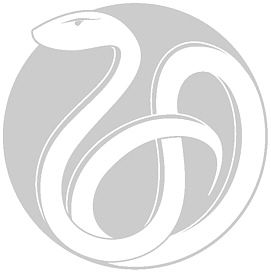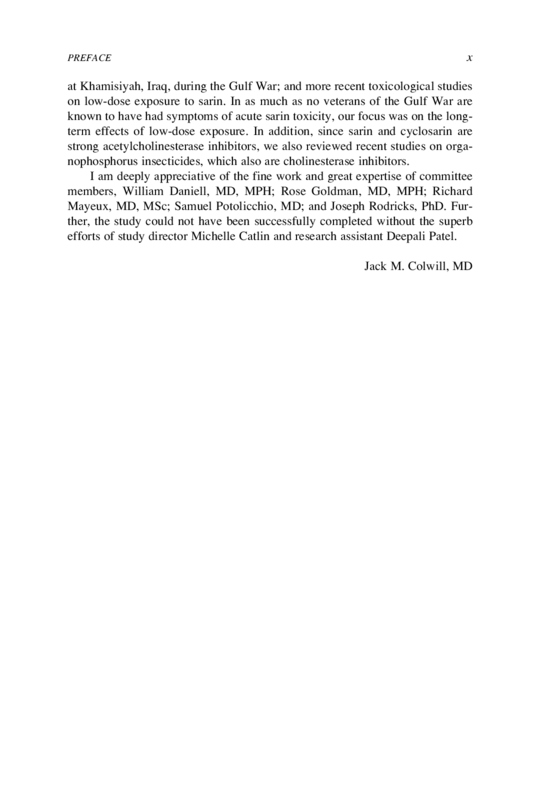GULF WAR and HEALTH
Updated Literature Review of Sarin
THE NATIONAL ACADEMIES PRESS
Washington, D.C. www.nap.edu
THE NATIONAL ACADEMIES PRESS
500 Fifth Street, NW Washington, DC 20001
NOTICE: The project that is the subject of this report was approved by the Governing Board of the National Research Council, whose members are drawn from the councils of the National Academy of Sciences, the National Academy of Engineering, and the Institute of Medicine. The members of the committee responsible for the report were chosen for their special competences and with regard for appropriate balance.
This study was supported by Cooperative Agreement V101(93)P-1637, TO #23 (VA-2794-123) between the National Academy of Sciences and the US Department of Veterans Affairs. Any opinions, findings, conclusions, or recommendations expressed in this publication are those of the author(s) and do not necessarily reflect the view of the organizations or agencies that provided support for this project.
International Standard Book Number 0-309-09294-9 (Book)
International Standard Book Number 0-309-54508-0 (PDF)
Additional copies of this report are available from the
National Academies Press,
500 Fifth Street, N.W., Lockbox 285, Washington, DC 20055; (800) 624-6242 or (202) 334-3313 (in the Washington metropolitan area); Internet, http://www.nap.edu.
For more information about the Institute of Medicine, visit the IOM home page at: www.iom.edu.
Copyright 2004 by the National Academy of Sciences. All rights reserved.
Printed in the United States of America.
The serpent has been a symbol of long life, healing, and knowledge among almost all cultures and religions since the beginning of recorded history. The serpent adopted as a logotype by the Institute of Medicine is a relief carving from ancient Greece, now held by the Staatliche Museen in Berlin.
THE NATIONAL ACADEMIES
Advisers to the Nation on Science, Engineering, and Medicine
The National Academy of Sciences is a private, nonprofit, self-perpetuating society of distinguished scholars engaged in scientific and engineering research, dedicated to the furtherance of science and technology and to their use for the general welfare. Upon the authority of the charter granted to it by the Congress in 1863, the Academy has a mandate that requires it to advise the federal government on scientific and technical matters. Dr. Bruce M. Alberts is president of the National Academy of Sciences.
The National Academy of Engineering was established in 1964, under the charter of the National Academy of Sciences, as a parallel organization of outstanding engineers. It is autonomous in its administration and in the selection of its members, sharing with the National Academy of Sciences the responsibility for advising the federal government. The National Academy of Engineering also sponsors engineering programs aimed at meeting national needs, encourages education and research, and recognizes the superior achievements of engineers. Dr. Wm. A. Wulf is president of the National Academy of Engineering.
The Institute of Medicine was established in 1970 by the National Academy of Sciences to secure the services of eminent members of appropriate professions in the examination of policy matters pertaining to the health of the public. The Institute acts under the responsibility given to the National Academy of Sciences by its congressional charter to be an adviser to the federal government and, upon its own initiative, to identify issues of medical care, research, and education. Dr. Harvey V. Fineberg is president of the Institute of Medicine.
The National Research Council was organized by the National Academy of Sciences in 1916 to associate the broad community of science and technology with the Academy’s purposes of furthering knowledge and advising the federal government. Functioning in accordance with general policies determined by the Academy, the Council has become the principal operating agency of both the National Academy of Sciences and the National Academy of Engineering in providing services to the government, the public, and the scientific and engineering communities. The Council is administered jointly by both Academies and the Institute of Medicine. Dr. Bruce M. Alberts and Dr. Wm. A. Wulf are chair and vice chair, respectively, of the National Research Council.
COMMITTEE ON GULF WAR AND HEALTH: UPDATED LITERATURE REVIEW OF SARIN
Jack M. Colwill (Chair), Professor Emeritus,
Department of Family and Community Medicine, University of Missouri-Columbia, Columbia, Missouri
William E. Daniell, Associate Professor,
Occupational and Environmental Medicine Program, Department of Environmental and Occupational Health Sciences, University of Washington, Seattle, Washington
Rose H. Goldman, Associate Professor of Medicine,
Harvard Medical School, Chief of Occupational & Environmental Medicine, Cambridge Health Alliance, Cambridge, Massachusetts
Richard Mayeux, Director,
Sergievsky Center, Columbia University, New York, New York
Samuel J. Potolicchio, Professor,
Department of Neurology, George Washington University Medical Center, Washington, DC
Joseph V. Rodricks, Managing Director,
ENVIRON International Corporation, Arlington, Virginia
Staff
Michelle C. Catlin, Study Director
Deepali Patel, Research Assistant
Norman Grossblatt, Senior Editor
Rose Marie Martinez, Director,
Board on Health Promotion and Disease Prevention
Consultant
Miriam Davis, Independent Medical Writer,
Silver Spring, Maryland
Reviewers
This report has been reviewed in draft form by persons chosen for their diverse perspectives and technical expertise, in accordance with procedures approved by the National Research Council’s Report Review Committee. The purpose of this independent review is to provide candid and critical comments that will assist the institution in making its published report as sound as possible and to ensure that the report meets institutional standards of objectivity, evidence, and responsiveness to the study charge. The review comments and draft manuscript remain confidential to protect the integrity of the deliberative process. We wish to thank the following for their review of this report:
Margit L. Bleecker, Director, Center for Occupational and Environmental Neurology, Baltimore, Maryland
Donald S. Burke, Department of International Health, Johns Hopkins Bloomberg School of Public Health, Baltimore, Maryland
Lucio G. Costa, Professor, Department of Environmental Health, University of Washington, Seattle, Washington
Bonnie L. Green, Professor of Psychiatry, Department of Psychiatry, Georgetown University, Washington, DC
David A. Savitz, Associate Professor of Epidemiology, Department of Epidemiology, University of North Carolina, Chapel Hill, North Carolina
Although the reviewers listed above have provided many constructive comments and suggestions, they were not asked to endorse the conclusions or recommendations, nor did they see the final draft of the report before its release. The review of
this report was overseen by Lauren A. Zeise, Chief, Office of Environmental Health Hazard Assessment, Reproductive and Cancer Hazard Assessment Section, California Environmental Protection Agency. Appointed by the National Research Council and Institute of Medicine, she was responsible for making certain that an independent examination of this report was carried out in accordance with institutional procedures and that all review comments were carefully considered. Responsibility for the final content of this report rests entirely with the authoring committee and the institution.
Preface
Following the Iraqi invasion of Kuwait in August of 1990, approximately 700,000 US troops were deployed to the Persian Gulf in 1990 and 1991. Although the duration of combat was short and casualties few, upon their return many of the Gulf War veterans began experiencing unexplained symptoms, such as muscle and joint pain, fatigue, difficulties of cognition, and headaches. Studies have shown that the prevalence of these symptoms clearly was higher among veterans who had been deployed to the Persian Gulf than among either those not deployed or those sent to other wars. This has led many to consider the possibility that exposures unique to the Persian Gulf Theater could be the source of the illnesses.
In 1998, in response to the health concerns of veterans and their families, the Department of Veterans Affairs contracted with the Institute of Medicine (IOM) to study the scientific evidence concerning possible adverse health effects of multiple agents to which veterans may have been exposed. To carry out this assignment, the IOM has convened three committees. The first committee report addressed the effects on health of four sets of compounds: depleted uranium, sarin and cyclosarin, pyridostigmine bromide, and vaccines against botulinum toxin and anthrax. The second committee reported on the health effects of exposure to insecticides and solvents. The third committee is currently reviewing the combustion products of oil-well fires, fuels, and compounds potentially used as propellants for Scud missiles.
Our ad hoc committee was asked to update the first committee’s report on outcomes of exposure to sarin and cyclosarin, in light of more recent studies of sarin exposure from terrorist attacks in Japan; possible sarin exposure of veterans
at Khamisiyah, Iraq, during the Gulf War; and more recent toxicological studies on low-dose exposure to sarin. In as much as no veterans of the Gulf War are known to have had symptoms of acute sarin toxicity, our focus was on the long-term effects of low-dose exposure. In addition, since sarin and cyclosarin are strong acetylcholinesterase inhibitors, we also reviewed recent studies on organophosphorus insecticides, which also are cholinesterase inhibitors.
I am deeply appreciative of the fine work and great expertise of committee members, William Daniell, MD, MPH; Rose Goldman, MD, MPH; Richard Mayeux, MD, MSc; Samuel Potolicchio, MD; and Joseph Rodricks, PhD. Further, the study could not have been successfully completed without the superb efforts of study director Michelle Catlin and research assistant Deepali Patel.
Jack M. Colwill, MD













